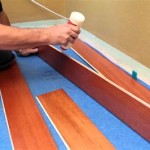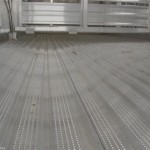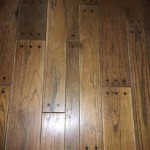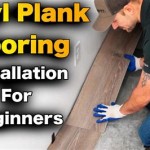French Bleed Laminate Flooring: A Detailed Examination
French bleed laminate flooring represents a specific aesthetic within the broader category of laminate flooring. Characterized by its distinctive dark, almost black, edges, this style aims to replicate the look of aged, reclaimed hardwood. It achieves this through a careful combination of distressing, текстури, and, most importantly, the application of a dark stain or paint along the bevels of each plank. The result is a floor with a depth and character often associated with antique materials, offering a cost-effective alternative to actual reclaimed wood.
The term "French bleed" itself is borrowed from the world of printing, where it refers to ink that extends beyond the trim edge of a page. In the context of flooring, it alludes to the visual effect of color "bleeding" or spreading beyond the expected boundaries of the plank. This design element contributes significantly to the overall aged and rustic appearance, making it a popular choice for those seeking a vintage or farmhouse aesthetic.
While aesthetically appealing, French bleed laminate flooring shares the same fundamental construction as other types of laminate flooring. Understanding this construction is crucial for making informed decisions regarding its suitability for specific applications. The typical laminate plank consists of four distinct layers:
1.
Wear Layer:
The uppermost layer, typically made of a clear, durable resin (often melamine) that protects the underlying decorative layer from scratches, stains, and fading. Its thickness directly correlates with the floor's resistance to wear and tear.2.
Decorative Layer:
This is a high-resolution photographic image of wood grain, stone, or other materials that provides the aesthetic appearance of the flooring. The quality of this image and the printing process significantly impacts the realism of the finish.3.
Core Layer:
This is the main structural component of the plank, typically constructed from high-density fiberboard (HDF) or medium-density fiberboard (MDF). The core determines the floor's resistance to impacts, indentation, and moisture. HDF is generally considered superior due to its higher density and increased resistance to moisture absorption.4.
Backing Layer:
The bottom layer, made of a moisture-resistant material, provides stability and helps prevent warping or cupping. It also serves as a barrier against moisture from the subfloor.Aesthetic Value and Design Applications
The primary appeal of French bleed laminate flooring lies in its ability to replicate the look of aged and distressed hardwood without the associated cost and maintenance. The dark edges create a strong visual contrast with the lighter center of the plank, accentuating the individual boards and adding depth to the floor. This is particularly effective in larger rooms, where the distinct lines of the planks can create a more visually interesting and dynamic space.
This type of flooring complements a variety of interior design styles. It works well in farmhouse-style homes, adding to the rustic and cozy atmosphere. It also pairs well with industrial-chic designs, providing a touch of warmth and texture to contrast with the cold, hard surfaces often found in these spaces. Furthermore, it can be used in more contemporary settings to add character and visual interest to an otherwise minimalist design. The contrast of the dark edges against a clean, modern backdrop can be quite striking.
The color palette typically associated with French bleed laminate flooring tends towards warm, natural tones. Wood finishes such as oak, hickory, and maple are common choices, often with a slightly distressed or textured surface to further enhance the aged appearance. The dark edges are typically a deep brown or black, providing a stark contrast that defines the style. However, variations exist, with some manufacturers offering French bleed laminate in lighter shades or with gray undertones to cater to different design preferences.
When selecting furniture and décor to complement French bleed laminate flooring, consider choosing pieces that enhance the rustic or vintage aesthetic. Leather furniture, antique rugs, and reclaimed wood accents can all work well. However, it is also important to balance the rustic elements with more modern pieces to avoid creating a space that feels overly cluttered or dated. A mix of old and new can create a more sophisticated and balanced look.
Advantages and Disadvantages Compared to Solid Hardwood
French bleed laminate flooring offers several advantages over solid hardwood, primarily in terms of cost, maintenance, and ease of installation. The cost of laminate flooring is significantly lower than that of solid hardwood, making it a more budget-friendly option for homeowners. The installation process is also generally simpler, with many laminate products featuring click-lock systems that allow for easy floating installation without the need for nails or glue. This can save on professional installation costs and make it a viable DIY project.
Maintenance is another key advantage. Laminate flooring is highly resistant to scratches, stains, and fading, making it easier to keep clean and looking its best. Unlike hardwood, it does not require regular sanding and refinishing. A simple routine of sweeping and mopping is typically sufficient to maintain its appearance. However, it is important to use a damp mop rather than a wet one to avoid water damage, especially around the edges of the planks.
Despite its advantages, laminate flooring also has some drawbacks compared to solid hardwood. One of the main disadvantages is its lack of authenticity. While French bleed laminate can effectively mimic the appearance of aged hardwood, it lacks the natural grain and texture of real wood. This can be a significant factor for those who value the authenticity and character of natural materials.
Another disadvantage is its susceptibility to water damage. While the backing layer provides some protection against moisture, laminate flooring is not completely waterproof. Prolonged exposure to water can cause the core layer to swell and warp, leading to permanent damage. This makes it less suitable for areas with high moisture levels, such as bathrooms and laundry rooms. Solid hardwood, while also susceptible to water damage, can often be repaired or refinished in the event of minor water damage, whereas laminate flooring typically requires replacement.
Finally, laminate flooring typically has a shorter lifespan than solid hardwood. While a well-maintained laminate floor can last for many years, it is not as durable or long-lasting as solid hardwood. Over time, the wear layer can become scratched or worn, and the planks may start to show signs of wear and tear. While solid hardwood can be sanded and refinished multiple times to restore its appearance, laminate flooring cannot be refinished.
Key Considerations for Installation and Maintenance
Proper installation is crucial for ensuring the longevity and performance of French bleed laminate flooring. The subfloor must be level, clean, and dry before installation can begin. Any unevenness or imperfections in the subfloor can cause the laminate planks to flex and move, leading to premature wear and tear. If the subfloor is not level, it may need to be leveled with a self-leveling compound or by grinding down high spots.
A moisture barrier is also essential, especially when installing laminate flooring over concrete. This barrier helps prevent moisture from seeping up from the concrete and damaging the core layer of the planks. Many laminate products come with an attached underlayment that includes a moisture barrier. However, if the product does not have an attached underlayment, a separate moisture barrier should be installed.
When installing French bleed laminate flooring, it is important to follow the manufacturer's instructions carefully. Pay particular attention to the expansion gaps required around the perimeter of the room. Laminate flooring expands and contracts with changes in temperature and humidity. If insufficient expansion gaps are left, the flooring can buckle or warp. These expansion gaps are typically covered by baseboards or quarter-round molding.
Regular maintenance is key to keeping French bleed laminate flooring looking its best. Sweep or vacuum the floor regularly to remove dirt, dust, and debris. Use a damp mop to clean the floor, but avoid using excessive water. Never use abrasive cleaners or scouring pads, as these can scratch the wear layer. Use a laminate floor cleaner specifically designed for laminate flooring. These cleaners are typically pH-neutral and will not damage the finish.
Protect the floor from scratches and dents by using furniture pads under the legs of chairs and tables. Avoid dragging heavy objects across the floor. Use doormats at entrances to prevent dirt and debris from being tracked onto the floor. Clean up spills immediately to prevent staining. With proper installation and maintenance, French bleed laminate flooring can provide years of beauty and durability.
In high-traffic areas, consider using area rugs to protect the laminate flooring from excessive wear. These rugs can also add warmth and style to the room. Rotate area rugs regularly to distribute wear evenly. Over time, the wear layer of laminate flooring can become scratched or worn. While it cannot be refinished like hardwood, heavily damaged planks can be replaced individually. Keep some extra planks on hand for this purpose.

Plyboard Brown Mp 4003 French Bleed Laminate Flooring At Rs 160 Sq Ft In Bengaluru

French Bleed Wooden Flooring At Rs 96 Square Feet Laminate Hardwood In New Delhi Id 20786555033

Victor Floor

Plyboard Gray Mp 4005 French Bleed Laminate Flooring At Rs 160 Sq Ft In Bengaluru

Treatment Black Bleed French Wide Plank Floor Supply

Victor Floor

6 Classy Shades Modern French Bleed Laminate Flooring For Indoor Thickness 8mm At Rs 60 Square Feet In Delhi

Understanding French Bleed Flooring A Detailed Guide

Victor Floor

Wooden Flooring Action Tesa Ac4 8mm French Bleed Premium 3584 Aasma World
Related Posts








